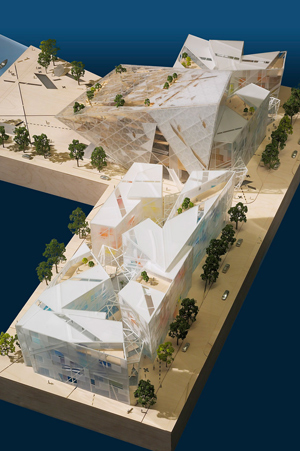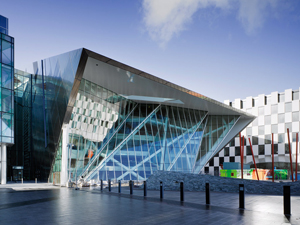 |
 |
 |
 |
 |
 |
| |
 |
|
 |
 |
 |
  |
  |
 |
 |
 |
 |
|
|
 |
|
 |
 |
 |
BUILDING |
 |
|
 |
|
 |
 |
 |
| |
 |
| 
 |
Grand Canal Square Theatre
|
|
 |
 |
 |
 |
DESIGNER |
 |
|
|
 |
|
 |
 |
 |
| |
 |
|
 |
 |
 |
 |
DESCRIPTION |
 |
|
|
 |
|
 |
 |
 |
|
|
 |
 The concept of the Grand Canal Square Theatre and Commercial Development is to build a powerful cultural presence expressed in dynamic volumes sculpted to project a fluid and transparent public dialogue with the cultural, commercial and residential surroundings whilst communicating the various inner forces intrinsic to the Theatre and office buildings. This composition creates a dynamic urban gathering place and icon mirroring the joy and drama emblematic of Dublin itself. The concept of the Grand Canal Square Theatre and Commercial Development is to build a powerful cultural presence expressed in dynamic volumes sculpted to project a fluid and transparent public dialogue with the cultural, commercial and residential surroundings whilst communicating the various inner forces intrinsic to the Theatre and office buildings. This composition creates a dynamic urban gathering place and icon mirroring the joy and drama emblematic of Dublin itself.
 The 2000 seat Grand Canal Theatre is a landmark that creates a focus for its urban context, specifically Grand Canal Square, the new urban piazza at the waterfront of Grand Canal Harbour. The architectural concept of the Theatre is based on stages: the stage of the Theatre itself, the stage of the piazza, and the stage of the multiple level Theatre lobby above the piazza. The Theatre becomes the main façade of a large public piazza that has a five star hotel and residences on one side and an office building on the other. The piazza acts as a grand outdoor lobby for the Theatre, itself becoming a stage for civic gathering with the dramatic Theatre elevation as a backdrop offering platforms for viewing. From its rooftop terrace, the Theatre offers spectacular views out over the Dublin Harbour. The 2000 seat Grand Canal Theatre is a landmark that creates a focus for its urban context, specifically Grand Canal Square, the new urban piazza at the waterfront of Grand Canal Harbour. The architectural concept of the Theatre is based on stages: the stage of the Theatre itself, the stage of the piazza, and the stage of the multiple level Theatre lobby above the piazza. The Theatre becomes the main façade of a large public piazza that has a five star hotel and residences on one side and an office building on the other. The piazza acts as a grand outdoor lobby for the Theatre, itself becoming a stage for civic gathering with the dramatic Theatre elevation as a backdrop offering platforms for viewing. From its rooftop terrace, the Theatre offers spectacular views out over the Dublin Harbour.
The Theatre is integrated into the Commercial Development by office buildings that include 45,500 square meters of leasable office and retail space. With their twin facades, glazed atriums and landscaped roofs, the two office blocks offer sustainable state of the art work environments. By designing multi-story glazed atriums, the commercial buildings integrate with the adjacent retail, residential, cultural and public space components. Three prominent entrances make the buildings accessible from Grand Canal Square, Misery Hill and from Cardiff Lane. Although both offices are designed in the same architectural language, each responds to its site uniquely. Two Grand Canal Square (South Block), which is adjacent to the new 2,000 seat Theatre, opens up towards the Square, while Four & Five Grand Canal Square (North Block), in conjunction with the Theatre, form a dramatic gateway to Dublin Harbour.
The Grand Canal Square Development enhances the new urban structure of Grand Canal Harbor with an exciting cultural landmark and magnet for Dublin, a destination for working, shopping, and entertainment. The planned opening of the Theater is in March 2010 and the Commercial Development is expected in mid 2010 and Mid 2011. |
|
 |
 |
 |
|
 |
|
|
|
 |
|
 |
 |
 |
 |
 |
 |
 |
MATERIALS |
 |
|
|
 |
|
 |
 |
 |
 |
 |
|
steel, reinforced concrete, ceramics, poliester, glass Theatre Volume
Stainless steel rain screen cladding panels on reinforced concrete and steel structure with strips of high performance glazing.
Theatre Glass Curtain
High performance glazing with exposed polyester powder coated pre-fabricated steel box sections.
Commercial Buildings
Low-iron unitized twin skin glazing system with geometric ceramic frit patterns with solar / glare perforated venetian blinds and capped unitized curtain walling with fixed blade louvers.
|
|
 |
 |
 |
 |
LOCATION |
 |
|
|
 |
|
 |
 |
 |

|
 |

|
Continent |
|
 |
|
Nation |
|
 |
|
Province |
|
 |
|
County |
|
 |
|
Town |
|
 |
|
Address |
|
 |
|
|
|
 |
|
Website |
|
 |
|
 |
 |
 |
 |
MAP |
 |
|
|
 |
|
 |
 |
 |
| |
 |
|
 |
 |
 |
 |
|
TYPOLOGY |
 |
|
|
 |
|
 |
 |
 |
Main |
 |
|
 |
ARCHITECTURE | Buildings for offices and professional practises
Offices
Buildings for recreational activities
Theatres
| |
|
|
 |
|
Additional |
 |
|
 |
ARCHITECTURE | Commercial buildings
Shops
Transport buildings and structures
Garages, car parking, etc.
| |
 |
 |
 |
 |
CHRONOLOGY |
 |
|
|
 |
|
 |
 |
 |
Project |
 |
|
 |
| 
 |
2004
project winner of competition
|
|
Realisation |
 |
|
 |
| 
 |
2006 - 2010 |
|
 |
 |
 |
 |
BIBILIOGRAPHIC REFERENCES |
 |
|
|
 |
|
 |
 |
 |
|
 |
Tom Wilkinson, "Opera Houses", Architectural Review 1400, october 2013, pp. 91-104
"Grand Canal Theatre, Dublin, Ireland", Architectural Review 1400, october 2013 |
|
|
| Jason O'Shaughnessy, Sandra Andrea O'Connell, "Daniel Libeskind in Dublin", Architecture Ireland 239, july-august 2008, p. 63 |
|
 |
 |
 |
 |
 |
 |
 |
CLIENT |
 |
|
|
 |
|
 |
 |
 |
| |
 |
| Ramford Limited, Chartered Land |
|
 |
 |
 |
 |
AMOUNT |
 |
|
|
 |
|
 |
 |
 |
| |
 |
|
 |
 |
 |
 |
DIMENSIONAL
DATA |
 |
|
|
 |
|
 |
 |
 |
| Surface |
 |
|
 |
South Office block sq.m. 21,092 (sq.ft. 226,992)
Theatre sq.m. 13,768 (sq.ft. 148,171)
North Office block sq.m. 33,320 (sq.ft. 358,590) |
|
| Floors |
 |
|
 |
|
| Capacity |
 |
|
 |
|
 |
 |
 |
 |
STRUCTURES |
 |
|
|
 |
|
 |
 |
 |
| |
 |
| ARUP Consulting Engineers - Dublin |
|
 |
 |
 |
 |
STAFF |
 |
|
|
 |
|
 |
 |
 |
Project  |
 |
| Architekt Daniel Libeskind AG |
|
|
 |
|
|
 |
|
Principal-in-charge |
 |
|
Project leader |
 |
|
Design team |
 |
| Feargal Doyle, Patrick Cox, Andreas Baumgärtner, Matthias Rühl, Toralf Sümmchen, Anna Poullou, Guillaume Chapallaz, Phil Binkert, Nathaniel Lloyd, Jens Jessen, Joana Pytlik, Marco Calvello, Niels Fehlig, Kaori Hirasawa, Maja Leonelli, Anja Bungies, Christian Müller, Julia Bauer |
|
Project management |
 |
| Lafferty Project Management |
|
Executive architect |
 |
| McCauley Daye O’Connell Architects, Dublin |
|
Theatre consultant |
 |
| Arts Team (part of RHWL Architects) |
|
Quantity surveyor |
 |
| Davis Langdon PKS, Dublin |
|
Systems |
 |
| ARUP Consulting Engineers, Dublin |
|
Acoustical consultant |
 |
| ARUP Acoustics, Winchester (UK) |
|
Architect of record |
 |
| ARUP Venue Consulting, Winchester (UK) |
|
Facades consultant |
 |
| Billings Design Associates, Dublin |
|
Lighting design |
 |
|
General contractor |
 |
| John Sisk & Son Ltd., Dublin |
|
 |
 |
 |
 |
ANNOTATIONS |
 |
|
|
 |
|
 |
 |
 |
| |
 |
|
 |
 |
 |
 |
CREDITS |
 |
|
|
 |
|
 |
 |
 |
| |
 |
Photos © Ros Kavanagh
Drawings © Studio Daniel Libeskind
Text edited by Studio Daniel Libeskind
Courtesy of Studio Daniel Libeskind
|
|
 |
  |
 |
|
|